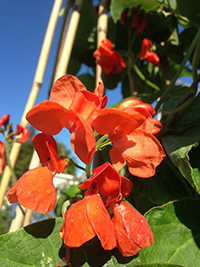Table of Contents
The SEEDS of the kidney bean plant have a high nutritious value, though when raw, they are toxic since they contain phaseolin, a toxalbumin that disappears when beans are cooked. Kidney bean seeds, called simply beans, were, along with corn, the base of the Mayan and Aztec meals, which had already cultivated several varieties. Early in the 20th century, it was revealed that kidney bean pods possessed some interesting medicinal properties.

Kidney Bean Plant Scientific Facts
- Other names: Bean.
- French: Haricot.
- Spanish: Judia, frijol, chaucha, habichuela.
- Environment: The kidney bean plant is native to Mexico and Central America; it has spread worldwide.
- Description: The annual plant of the Leguminosae family has a climbing stem that grows up to 3 m high in some varieties, while others have creeping stems. The fruit is yellow or green pods, which contain several kidney-shaped seeds.
- Parts of the plant used medicinally: The pods covering the seeds.
Healing Properties

Kidney bean pods contain several amino acids, especially arginine and vitamins A, B, and C, mineral salts, trace elements, bran, and starch. They also present three basic properties.
- Thanks to arginine and mineral salts, they are diuretics. They do not have the adverse effects of most pharmaceutical diuretic substances, such as potassium loss. This property is helpful for edema produced by coronary or renal insufficiency and pre-menstrual liquid retention. They are also used for gout and kidney stones since they promote the elimination of uric acid.
- Cardiotonic. This property of kidney bean pods is similar to that of the foxglove plant but much milder. They improve the strength of heart contractions and their overall performance.
- Hypoglycemic. A decoction of kidney bean pods is used to decrease the blood sugar level.
How to use Kidney Bean

- As vegetables. Cooked green pods can be eaten after being dressed with oil and lemon juice. They also have hypoglycemic properties, though less intense than when taken in a decoction.
- Decoction with 100 grams of dry bean pods per liter of water, boiling until the liquid reduces to half. The resulting liquid should be drunk during the day.
Kidney Bean Plant to Treat Diabetes
Arginine is an amino acid present in high amounts in bean pods. It has similar properties to glycoquine (plant insulin) and decreases blood sugar levels.
As a complementary treatment of diabetes, a decoction of bean pods allows a reduction of insulin dosage or that of oral antidiabetic substances. A doctor must monitor this reduction.
Frequently Asked Question
I know kidney beans have fiber, but what kind of fiber do they contain, and how much does it help?
Kidney beans offer a fantastic mix of both soluble and insoluble fiber. Soluble fiber creates a gel-like consistency in your gut, aiding digestion and potentially lowering cholesterol.
Insoluble fiber promotes consistency and helps prevent constipation.
Can the kidney bean plant help with blood sugar control?
Yes! Their low glycemic index means they release sugar slowly into the bloodstream, preventing spikes. This is beneficial for those with diabetes or pre-diabetes. Kidney beans are also high in resistant starch, which your gut bacteria ferment, potentially boosting insulin sensitivity.
I’ve heard the kidney bean plant is suitable for the heart. Why is that?
Several factors contribute:
Fiber helps lower cholesterol, a significant risk factor for heart disease. Its folate content helps reduce homocysteine levels, an amino acid linked to higher heart disease risk. Fiber is also a rich potassium source for healthy blood pressure regulation.
Does the kidney bean plant offer antioxidant benefits?
Absolutely! They contain anthocyanins, the pigments giving them their color. Anthocyanins are potent antioxidants linked to a reduced risk of cancer, heart disease, and diabetes.
Can the kidney bean plant help with weight management?
Yes, they can be a valuable tool. Kidney beans are:
High in protein and fiber, promoting feelings of fullness. It is also a low-calorie-dense food, meaning you get a lot of volume for relatively few calories.
Can eating too many kidney beans be bad for you?
While highly nutritious, moderation is essential. Overconsumption can lead to:
Digestive discomfort due to high fiber content. Potential interference with nutrient absorption from lectins (reduced by proper cooking).
I’m on a gluten-free diet. Is the kidney bean plant safe for me?
Yes! Kidney beans are naturally gluten-free, making them an option for those with Celiac disease or gluten sensitivity.
Do canned beans offer the same benefits as dried beans?
Mostly! Canned beans are a convenient option. Key points:
Opt for low-sodium or no-salt-added varieties. They may be slightly lower in some nutrients due to processing.
Are there ways to improve the benefits of kidney beans?
Yes! Here are a few tips:
Sprouting kidney beans before cooking can increase nutrient availability. Combining them with vitamin C-rich foods (like bell peppers or citrus) will improve iron absorption.
Are there people who should be cautious with kidney beans?
In general, kidney beans are safe for most people. However, consult your doctor if:
Their potassium content may need to be monitored if you have kidney issues.
You take blood thinners, as the vitamin K in kidney beans could interfere.
DISCLAIMER: All content on this website is presented solely for educational and informational objectives. Do not rely on the information provided as a replacement for advice, diagnosis, or treatment from a qualified medical expert. If you are pregnant, nursing, or have any preexisting medical concerns, talk to your doctor before using any herbal or natural medicines.
REFERENCES
- George D. Pamplona-Roger, M.D. “Encyclopedia of Medicinal Plants.” George D. Pamplona-Roger, M.D. Encyclopedia of Medicinal Plants. Ed. Francesc X. Gelabert. vols. 2 San Fernando de Henares: Editorial Safeliz, 2000. 584. Print. [kidney bean plant]
- Healthline: https://www.healthline.com/nutrition/foods/kidney-beans
- WebMD: https://www.webmd.com/diet/health-benefits-kidney-beans
- EatingWell: https://www.eatingwell.com/article/8013408/are-kidney-beans-healthy/
- Practo: https://www.practo.com/
Last update on 2024-07-22 / Affiliate links / Images from Amazon Product Advertising API





